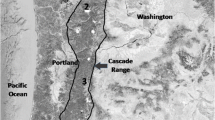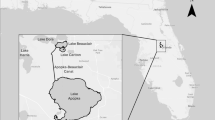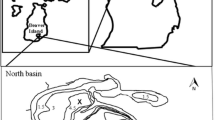Abstract
Thirty-two northern Florida lakes were analyzed to construct a transfer function relating surface sediment diatom assemblages to lakewater pH (R 2=0.89, s.e.=0.34). A paleoecological analysis of sediment cores from six of these lakes indicated that two have become more acidic in the last 50 years. The diatom inferred (DI) pH of L. Barco has declined between 0.56–0.82 in the 1900's and DI ANC (acid neutralizing capacity) by 28–46 μeq l-1. The DI pH of nearby L. Suggs has declined 0.91 pH units and its DI ANC by 19 μeq l-1. The timing of the inferred acidification is synchronous with known increases in emissions of sulfates and nitrates that are associated with acidic precipitation. Also, the increasing accumulation of substances related to emissions from the burning of fossil fuels (e.g., Pb, PAH) co-occurs with the lowering of DI pH in the sedimentary record. However, other processes may have accounted for or contributed to recent lake acidification. For instance, the drawdown of local water tables by human consumption may decrease the inseepage of ANC to seepage lakes. Such an effect would be synchronous with increasing depositions of sulfate. There is also clear evidence that Florida lakes are naturally acidic. Thus, paleoecological results indicate acidic deposition to be at certain contributor, but not necessarily the sole cause, of the recent further acidification of some naturally acidic Florida lakes.
Similar content being viewed by others
References
Anderson, D. S., R. B. Davis & F. Berge, 1986. Relationships between diatom assemblages in lake surface-sediments and limnological characteristics in southern Norway. In: Smol, J. P., R. W. Battarbee, R. B. Davis & J. Meriläinen (eds.), Diatoms and Lake Acidity. W. Junk Publishers, Dordrecht, pp. 97–113.
Arzet, K., C. Steinberg, R. Psenner & N. Schulz, 1986. Diatom distribution and diatom-inferred pH in the sediment of four alpine lakes. Hydrobiologia 143: 247–254.
Baker, L. A. & P. L. Brezonik, 1988. Dynamic model of in-lake alkalinity generation. Wat. Res. 24: 65–74.
Baker, L. A., P. L. Brezonik & C. D. Pollman, 1986. Model of internal alkalinity generation: sulfate retention component. Wat. Air. Soil Pollut. 31: 89–94.
Baker, L. A., C. D. Pollman & J. M. Eilers, 1988. Alkalinity regulation in softwater Florida lakes. Wat. Res. 24: 1069–1082.
Baron, J., S. A. Norton, D. R. Beeson & R. Harriman, 1986. Sediment diatom and metal stratigraphy from Rocky Mountain lakes with special reference to atmospheric deposition. Can. J. Fish. aquat. Sci. 43: 1350–1362.
Battarbee, R. W., 1984. Diatom analysis and the acidification of lakes. Phil. Trans. r. Soc., Lond. B. 305: 451–477.
Battarbee, R. W. & D. F. Charles, 1987. The use of diatom assemblages in lake sediments as a means of assessing the timing, trends, and cuases of lake acidification. Progress in Physical Geography 11: 552–580.
Binford, M. W., 1990. Calculation and uncertainty analysis of 210Pb dates for PIRLA project lake sediment cores. J. Paleolim. (in press).
Binford, M. W. & M. Brenner, 1986. Dilution of 210Pb by organic sedimentation in lakes of different trophic states, and application to studies of sediment-water interactions. Limnol. Oceanogr. 31: 584–595.
Binford, M. W., M. Brenner, T. J. Whitmore, A. Higuera-Gundy, E. S. Deevey & B. Leyden, 1987. Ecosystems, paleoecology, and human disturbance in subtropical and tropical America. Quat. Sci. Rev. 6: 115–128.
Binford, M. W., J. S. Kahl & S. A. Norton, in prep. 210Pb studies in PIRLA project lakes. J. Paleolim.
Birks, H. J. B., J. M. Line, S. Juggins, A. C. Stevenson & C. J. F.ter Braak, 1990. Diatoms and pH recomstruction. Phil. Trans. r. Soc., Lond. B. 327: 263–278.
Brenner, M. & M. W. Binford, 1986. Material transfer from water to sediment in Florida lakes. Hydrobiologia 143: 55–61.
Brenner, M., M. W. Binford & E. S. Deevey, 1990. Lakes. In: Myers, R. L. & J. J. Ewel (eds.), Ecosystems of Florida, Univ. Presses of Florida, Gainesville, FL., p. 252–270.
Brezonik, P. L., C. D. Hendry, E. S. Edgerton, R. L. Schultz & T. L. Crisman, 1983. Acidity, nutrients, and minerals in atmospheric precipitation over Florida: deposition patterns, mechanisms and ecological effects. Environmental Protection Agency, Corvallis, Oregon, EPA-600/3–83–004, NTIS No. P8 83 165837, 170 p.
Camburn, K. E., J. C. Kingston & D. F. Charles, 1986. PIRLA diatom iconograph. Report number 3, PIRLA Unpublished Report Series, Bloomington, IN. (53 photographic plates, 1059 figures.)
Canfield, D. E., 1983. Sensitivity of Florida lakes to acidic precipitation. Wat. Res. 19: 833–839.
Carlisle, V. W., C. T. Hallmark, F. Sodek, R. E. Caldwell, L. C. Hammond & V. E. Berkheiser, 1981. Characterization Data for Selected Florida Soils. Soil Science Research Report Number 81–1, University of Florida, Gainesville, Florida, 305 p.
Charles, D. F. & D. R. Whitehead (eds.), 1986. Paleoecological investigation of recent lake acidification, methods and project description. Report EPRI EA-4906. Project 2174–10, Electric Power Research Institute, Palo Alto, CA, U.S.A.
Charles, D. F., M. W. Binford, E. T. Furlong, R. A. Hites, M. J. Mitchell, S. A. Norton, F. Oldfield, M. J. Paterson, J. P. Smol, A. J. Uutala, J. R. White, D. R. Whitehead & R. J. Wise, 1990. Paleolimnological evidence of recent acidification in the Adirondack Mountains, N.Y. J. Paleolim. (in press).
Charles, D. F., D. R. Whitehead, D. R. Engstrom, B. D. Fry, R. A. Hites, S. A. Norton, J. S. Owen, L. A. Roll, S. C. Schindler, J. P. Smol, A. J. Uutala, J. R. White & R. J. Wise, 1987. Paleolimnological evidence for recent acidification of Big Moose Lake, Adirondack Mountains, N.Y. (U.S.A.). Biogeochemistry 3: 267–296.
Charles, D. F., D. R. Whitehead, D. S. Anderson, R. Bienert, K. E. Camburn, R. B. Cook, T. L. Crisman, R. B. Davis, J. Ford, B. D. Fry, R. A. Hites, J. S. Kahl, J. C. Kingston, R. G. Kreis, M. J. Mitchell, S. A. Norton, L. A. Roll, J. P. Smol, P. R. Sweets, A. J. Uutala, J. R. White, M. C. Whiting & R. J. Wise, 1986. The PIRLA Project (Paleoecological investigation of recent lake acidification): preliminary results for the Adriondacks, New England, N. Great Lakes States, and N. Florida. Wat. Air Soil Pollut. 30: 355–365.
Clark, W. E., R. H. Musgrave, C. G. Menke & J. W. CagleJr., 1964. Water resources of Alachua, Bradford, Clay, and Onion counties, Florida. Florida Geological Survey, Report of Investigations. Report No. 35, Tallahassee, FL, U.S.A.
Cook, R. B. & D. W. Schindler, 1983. The biogeochemistry of sulfur in an experimentally acidified lake. Env. Biogeochem. Ecol. Bull. (Stockholm) 35: 115–127.
Davis, R. B., 1974. Stratigraphic effects of tubificids in profundal lake sediments. Limnol. Oceanogr. 19: 466–488.
Davis, R. B. & D. S. Anderson, 1985. Methods of pH calibration of sedimentary diatom remains for reconstructing history of pH in lakes. Hydrobiologia 120: 69–87.
Davis, R. B. & J. P. Smol, 1986. The use of sedimentary remains of siliceous algae for inferring past chemistry of lake water-problems, potential and research needs. In: Smol, J. P., R. W. Battarbee, R. B. Davis & J. Meriläinen (eds.), Diatoms and Lake Acidity, 291–300. Dr. W. Junk, Dordrecht, The Netherlands.
Davis, R. B., D. S. Anderson & F. Berge, 1985. Loss of organic matter, a fundamental process in lake acidification: paleolimnological evidence. Nature 316: 436–438.
Deevey, E. S.Jr., 1988. Estimation of downward leakage from Florida lakes. Linol. Oceanogr. 33: 1308–1320.
Deevey, E. S., M. W. Binford, M. Brenner & T. J. Whitmore, 1986. Sedimentary records of accelerated nutrient loading in Florida lakes. Hydrobiologia 143: 49–53.
Dixit, A. S., S. S. Dixit & R. D. Evans, 1988. The relationship between sedimentary diatom assemblages and lakewater pH in 35 Quebec lakes, Canada. J. Paleolim. 1: 23–28.
Environmental Science and Engineering, Inc. (ESE), 1987. Florida acid deposition study. Five-year data summary. ESE No. 85-186-0106-2110. Gainesville, Florida.
Fernald, E. A., 1981. Atlas of Florida. Florida State University Press, Tallahassee.
Fernald, E. A. & D. J. Patton, 1984. Water resources atlas of Florida. Florida State University Press, Tallahassee.
Furlong, E. A., L. Roll-Cesar & R. A. Hites, 1987. Polycyclic aromatic hydrocarbons in PIRLA lake sediments. Geoch. Cosmochim. Acta. 51: 2965–2975.
Garren, R. A., 1990. Watershed characteristics and recent history of PIRLA northern Florida core lakes. PIRLA Unpublished Report Series, Report Number 15, Department of Environmental Engineering Sciences, University of Florida, Gainesville, FL.
Goldstein, R. A. & S. A. Gherini, 1984. The integrated lake-watershed acidification study, volume 4: summary of major results. Report EPRI EA-3221, Project 1109–5, Electric Power Research Institute, Palo Alto, California, U.S.A.
Healy, H. G., 1975. Potentiometric surface and areas of artesian flow of the Florida Aquifer in Florida. Map Series, 73. Department of Natural Resources, Bureau of Geology, Tallahassee, FL.
Heath, R. C. & C. S. Conover, 1981. Hydrologic Almanac of Florida, U.S. Geological Survey Open File Report 81-1107, Tallahassee, FL.
Hendry, D. D. & P. L. Brezonik, 1984. Chemical composition of softwater Florida lakes and their sensitivity to acid precipitation. Wat. Res. Bull. 20 (1): 75–86.
Husar, R. B., 1990. Emissions of sulfur dioxide and nitrogen oxides and trends for eastern North America. In: Charles, D. F. (ed.), Acid Deposition and Aquatic Ecosystems: Regional Case Studies. Regional Case Studies Project, EPA.
Husar, R. B., 1986. Emissions of sulfur dioxide and nitrogen oxides and trends for eastern North America, pp. 48–92. In: Acid Deposition: Long Term Trends. National Research Council, National Academy Press, Washington, D.C.
Hustedt, F. R., 1939. Systematische und ökologische Untersuchungen über die Diatomeen Flora von Java, Bali, und Sumatra nach dem Material der Deutschen Limnologischen Suda-Expedition III. Die ökologischen Faktoren und Ihr Einfluss auf die Diatomeenflora. Arch. Hydrobiol. Supp. 16: 274–394.
Kelly, C. A. & J. W. M. Rudd, 1984. Epilimnetic sulfate reduction and its relationship to lake acidification. Biogeochemistry 1: 63–77.
Kingston, J. C. & H. J. B. Birks, 1990. Dissolved organic carbon reconstructions from diatom assemblages in PIRLA project lakes, North America. Phil. Trans. r. Soc., Lon. B. 327: 279–288.
Kingston, J. C., R. B. Cook, R. G. Kreis, Jr., K. E. Camburn, S. A. Norton, P. R. Sweets, M. W. Binford, M. J. Mitchell, S. C. Schindler, L. C. K. Shane & G. King, 1990. Paleoecological investigation of recent lake acidification in the Northern Great Lakes States. J. Paleolim. (in press).
Kreis, R. G., Jr., 1989. Variability study — interim results. Paleoecological Investigation of Recent Lake Acidification (PIRLA): 1983–1985. Electric Power Research Institute, EPRI EN-6526, Palo Alto, CA.
Krug, E. C. & C. R. Frink, 1983. Acid rain on acid soil: a new perspective. Science 221: 520–525.
Kuhn, D. L., J. L. Plafkin, J. Cairns & R. L. Lowe, 1981. Qualitative characterization of aquatic environments using diatom life-form strategies. Trans. am. Microsc. Soc. 100: 165–182.
LaZerte, B. & P. Dillon, 1984. Relative importance of anthropogenic versus natural sources of acidity in lakes and streams of central Ontario. Can. J. Fish. aquat. Sci. 41: 1664–1677.
Leavitt, P. R. & S. R. Carpenter, 1989. Effects of sediment mixing and benthic algal production on fossil pigment stratigraphies. J. Paleolim. 2: 147–158.
Likens, G. E., 1985. An ecosystem approach to aquatic ecology. Springer-Verlag, New York, U.S.A.
Linthurst, R. A., D. H. Landers, J. M. Eilers, D. F. Brakke, W. S. Overton, E. P. Meier & R. E. Crowe, 1986. Characteristics of Lakes in the Eastern United States, Volume I. Population Descriptions and Physico-Chemical Relationships. EPA/600/4–86/007a, U.S. Environmental Protection Agency, Washington, D.C., 136 p.
Lowe, R. L., 1974. Environmental requirements and pollution tolerance of freshwater diatoms. U.S. EPA, Environmental Monitoring Series, 670-4-74-005, Cincinnati, U.S.A.
Mitchell, M. J., J. S. Owen & S. S. Schindler, 1990. Factors affecting sulfur incorporation to sediments: paleoecological implications. J. Paleolim. (in press).
Mitchell, M. J., S. C. Schindler, J. S. Owen & S. A. Norton, 1988. Comparison of sulfur concentrations within lake sediment profiles. Hydrobiologia 157: 219–229.
Norton, S. A., R. W. Bienert, Jr., M. W. Binford & J. S. Kahl, 1990. Stratigraphy of total metals in PIRLA cores. J. Paleolim. (in press).
Patrick, R., V. Binetti & S. G. Halterman, 1981. Acid lakes from natural and anthropogenic causes. Science 211: 446–448.
Pillsbury, R. W. & J. C. Kingston, 1990. The pH-independent effect of aluminum on cultures of phytoplankton from an acidic Wisconsin lake. Hydrobiologia 194: 225–233.
Pollman, C. D. & D. E. Canfield, 1990. Florida hydrologic and biogeochemical controls on seepage lake chemistry. In: Charles, D. F. (ed.), Acid Deposition and Aquatic Ecosystems: Regional Case Studies. Regional Case Studies Project, EPA.
Renberg, I. & T. Hellberg, 1982. The pH history of lakes in southwestern Sweden, as calculated from the subfossil diatom flora of the sediments. Ambio 11: 30–33.
Rudd, J. W. M., 1987. Acidification of the Moose River system in the Adirondack Mountains of New York State. Biogeochemistry special issue. Nijhoff/Junk, Dordrecht, The Netherlands.
Rudd, J. W. M., C. A. Kelly & A. Furutani, 1986. The role of sulfate reduction in long term accumulation of organic and inorganic sulfur in lake sediments. Limnol. Oceanogr. 31: 1281–1291.
Schindler, D. W., 1988. Effects of acid rain on freshwater ecosystem. Science 239: 149–157.
Smith, M. A., 1990. The ecophysiology of epilithic diatom communities of acid lakes in Galloway, southwest Scotland. Phil. Trans. r. Soc., Lond. B. 327: 251–256.
Sweets, P. R., 1990. Diatom counts of northern Florida lake surface sediment samples and sediment core intervals. PIRLA Unpublished Report Series, Report Number 14, Department of Biology, Indiana University, Bloomington, IN.
Sweets, P. R., 1983. Differential deposition of diatom frustules in Jellison Hill Pond, ME. MS Thesis, University of Maine, Orono, ME.
Sweets, P. R., R. A. Garren & R. G. Kreis, 1989. The relationship between surface sediment diatoms and pH in northern Florida. Paleoecological Investigation of Recent Lake Acidification (PIRLA): 1983–1985. Electric Power Research Institute, EPRI EN-6526, Palo Alto, CA.
ter Braak, C. J. F., 1986. Canonical correspondence analysis: a new eigenvector technique for multivariate direct gradient analysis. Ecology 67: 1167–1179.
ter Baak, C. J. F., 1987. The analysis of vegetation-environment relationships by canonical correspondence analysis. Vegetatio 69: 69–77.
Watts, W. A. & B. C. S. Hansen, 1988. Environments of Florida in the late Wisconsin and Holocene. In: Purdy, B. (ed.), Wet Site Archaeology. Telford Press, Caldwell, NJ, U.S.A.: 307–323.
Watts, W. A. & M. Stuiver, 1980. Late Wisconsin climate of northern Florida and the origins of species-rich deciduous forest. Science 210: 325–327.
Whiting, M. C., D. R. Whitehead, R. W. Holmes & S. A. Norton, 1989. Paleolimnological reconstruction of the recent acidity changes in four Sierra Nevada lakes. J. Paleolim. 2: 285–304.
Whitmore, T. J., 1989. Florida diatom assemblages as indicators of tropohic state and pH. Limnol. Oceanogr. 34: 882–895.
Author information
Authors and Affiliations
Additional information
This is the tenth of a series of papers to be published by this journal which is a contribution of the Paleoecological Investigation of Recent Lake Acidification (PIRLA) project. Drs. D. F. Charles and D. R. Whitehead are guest editors for this series.
Rights and permissions
About this article
Cite this article
Sweets, P.R., Bienert, R.W., Crisman, T.L. et al. Paleoecological investigations of recent lake acidification in northern Florida. J Paleolimnol 4, 103–137 (1990). https://doi.org/10.1007/BF00226320
Accepted:
Issue Date:
DOI: https://doi.org/10.1007/BF00226320




